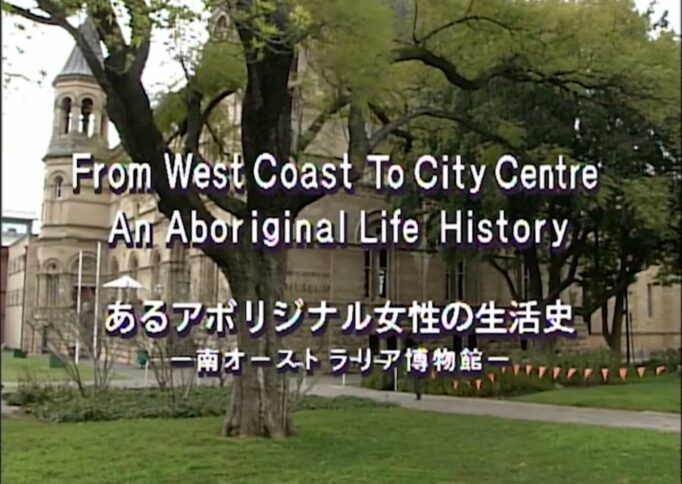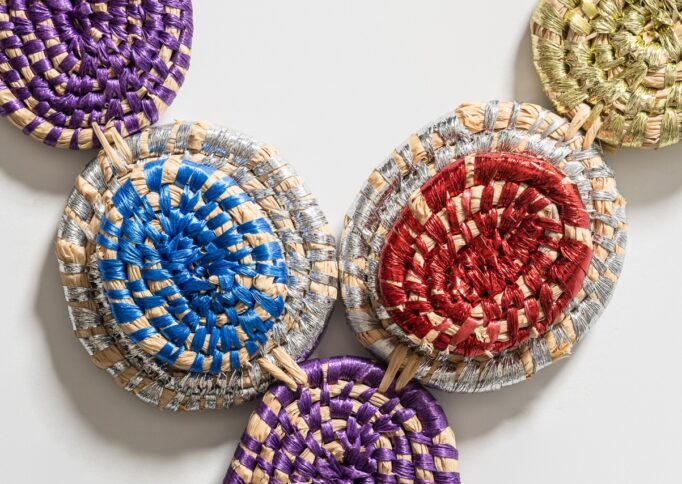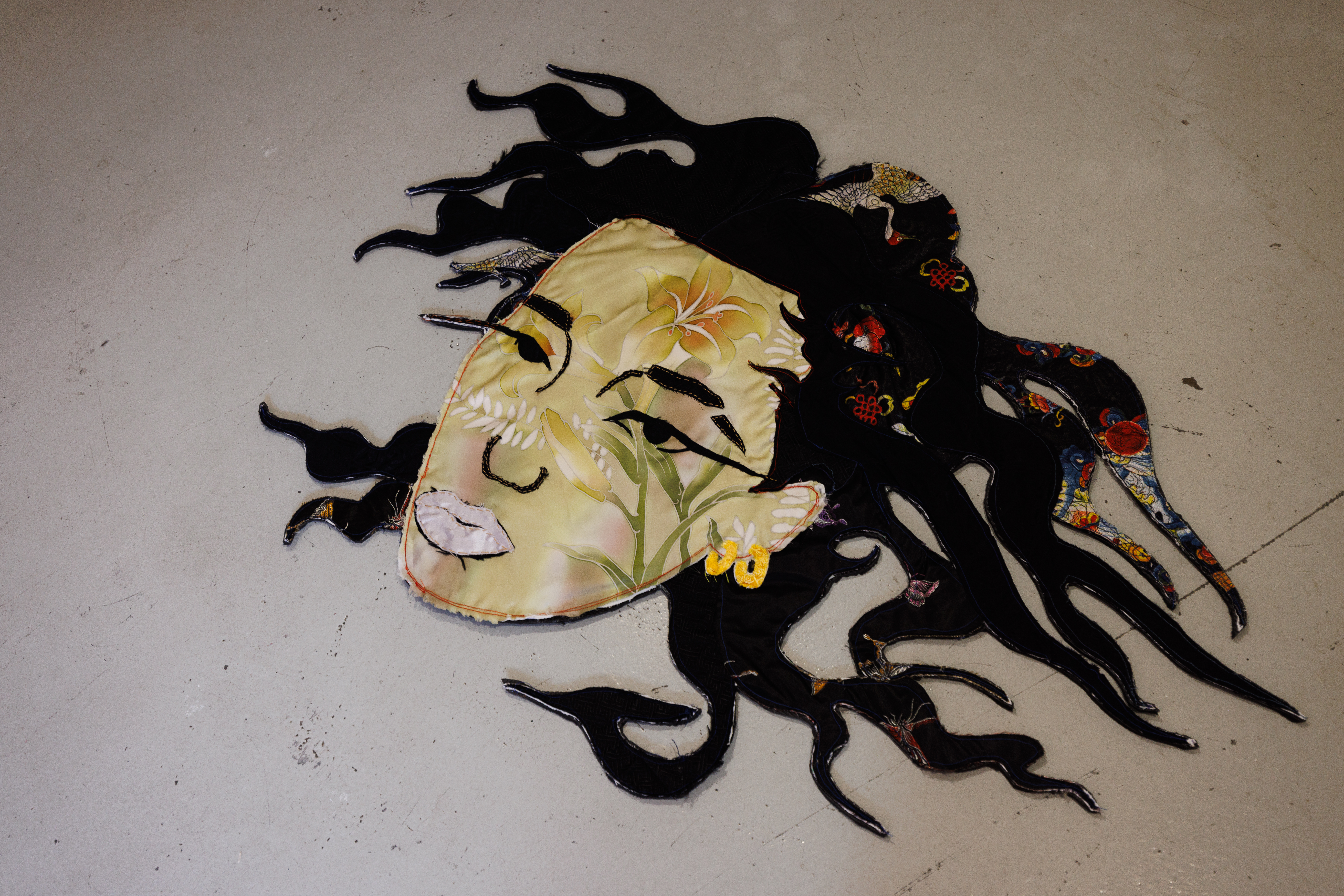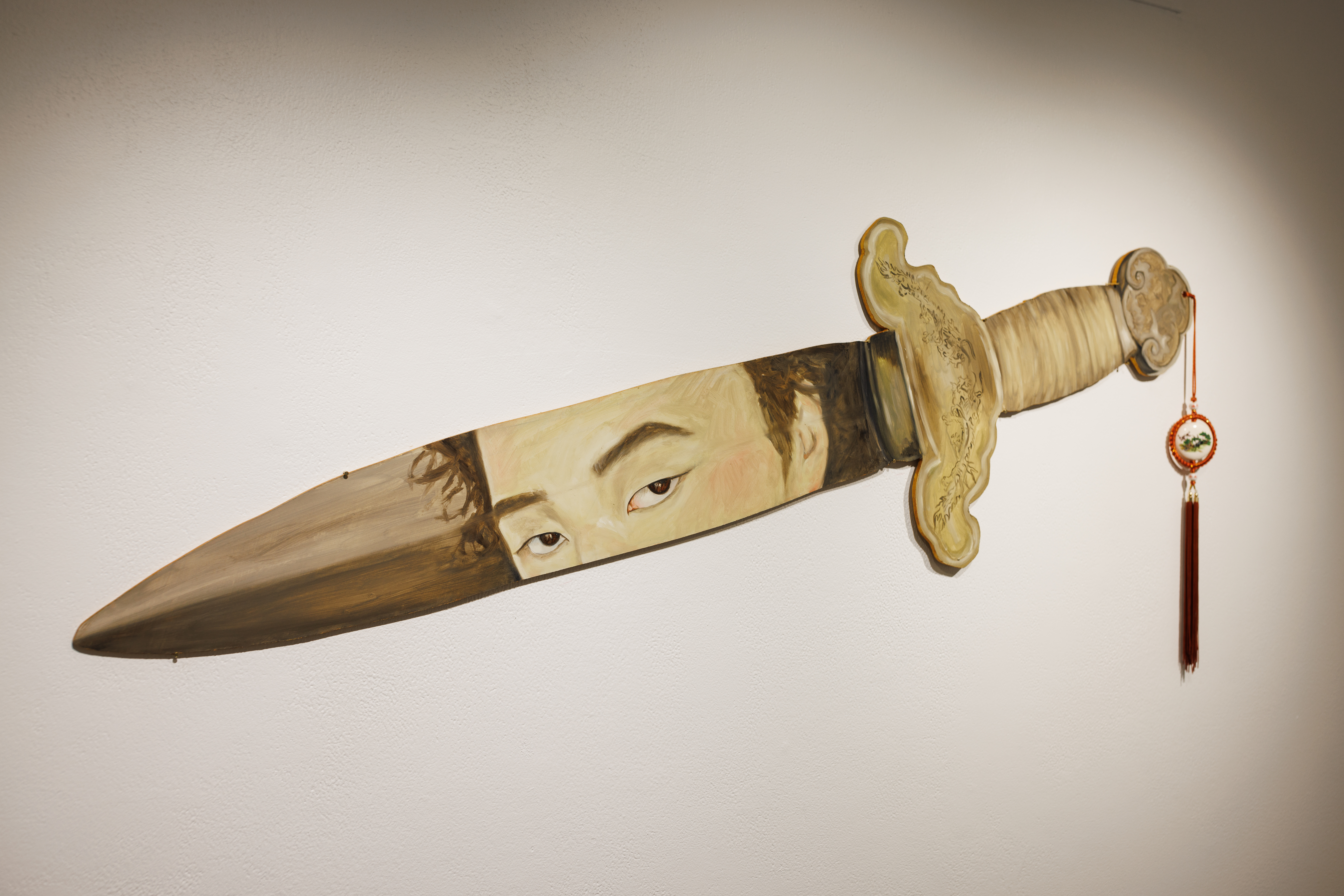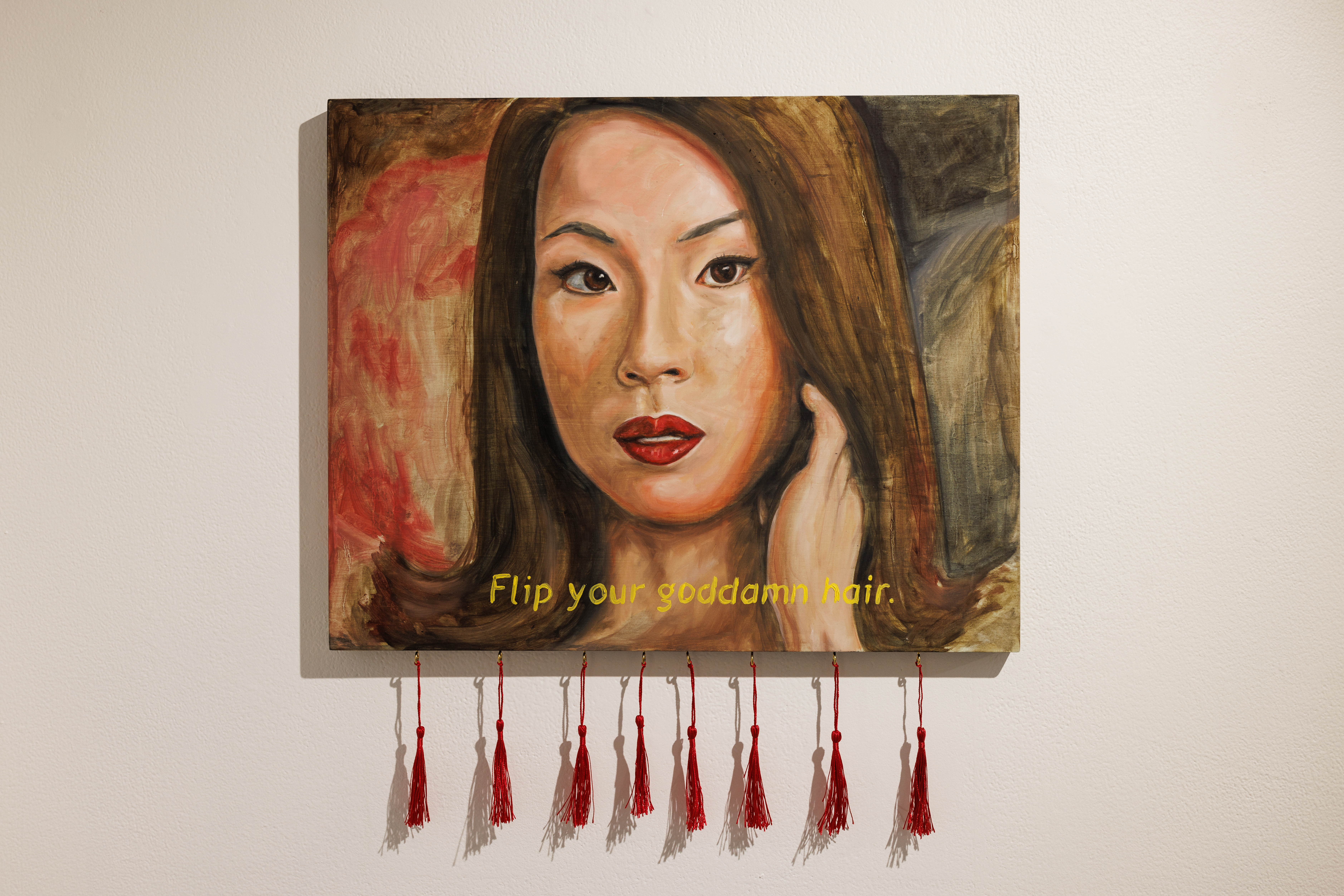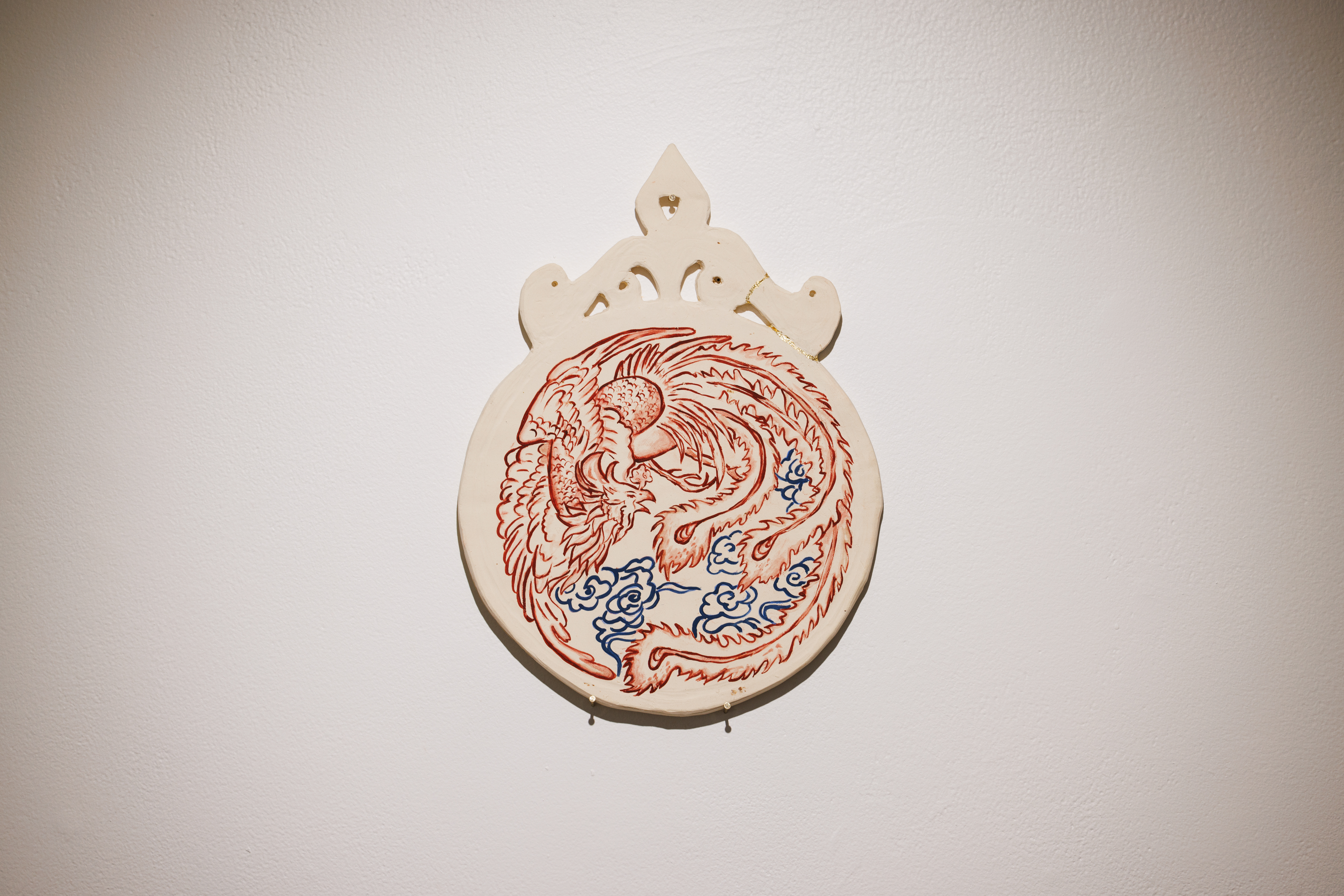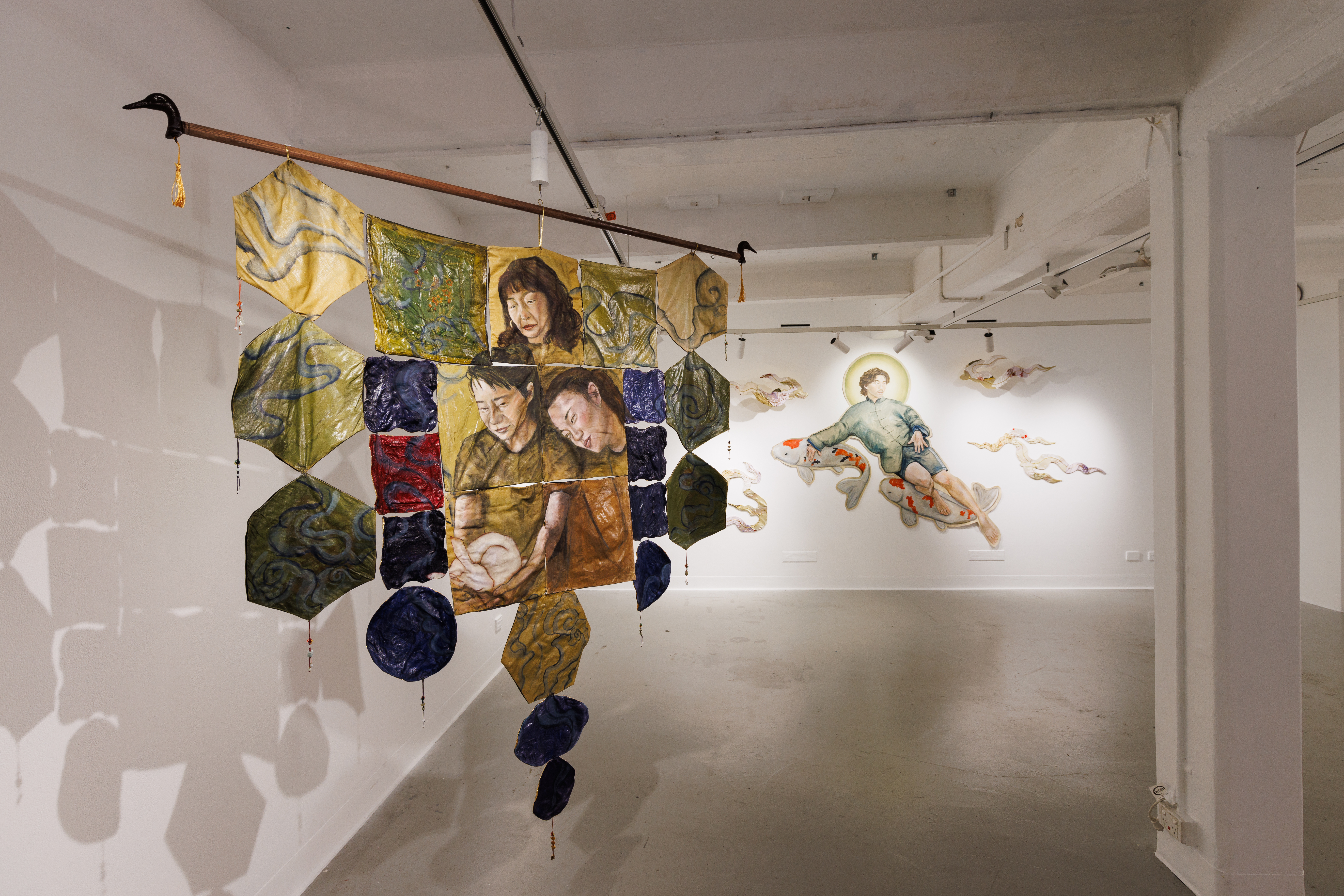Exhibition
Walk on by
Jake Yang
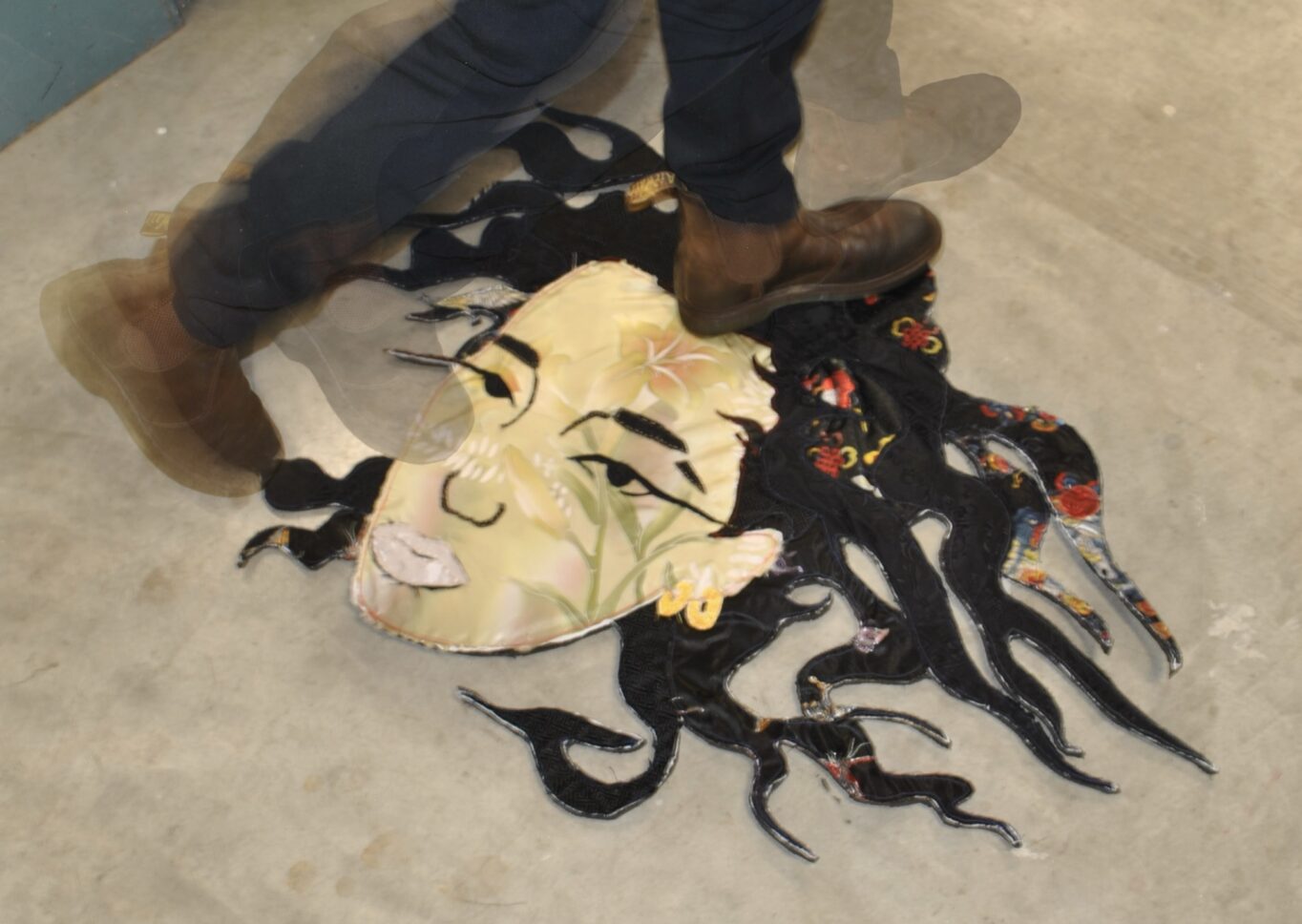
About the exhibition
Jake Yang
Jake Yang’s art practice explores queer youth culture and the way it sits alongside and intersects with his cultural background, raised in a conservative traditional Chinese culture. In Yang’s work privacy, intimacy, care, and freedom are celebrated in lush, safe natural environments.
He challenges normative assumptions through an examination of intersecting identities and existing in three very different cultures simultaneously. His practice explores internal conflict, a sense of fracture as well as the longing for cross-sacredness and celebration of safe spaces.
In this solo exhibition Yang uses painting and textile sculpture to explore the glorified and fierce Asian figure, and the process of neglect, acceptance, and celebration of culture reflected in his relationship with identity.
Nexus Arts Gallery
13 February 2025- 21 March 2025
Below is an audio description of three works from the exhibition: Womf (walk on my face), Serving celestial and Nurture
Walk on by
AUDIO DESCRIPTION SCRIPT
NEXUS ARTS
“WALK ON BY”
THREE WORKS
INTRO
This is an audio description of three works within the exhibition walk on by, a body of work by artist Jake Yang, exhibited at the Nexus Gallery 14 February to 21 March 2025. The exhibition is comprised of a number of individual pieces, which are exhibited together to form the full work, in the gallery space at Nexus Arts, on Kaurna Country, Adelaide, South Australia.
The Nexus gallery space measures six point seven metres deep and six point four metres wide, with white walls and a light grey painted concrete floor, and a single white rectangular column at its centre.
Pieces that comprise this work are displayed throughout the space, on its floor and walls, and suspended from the ceiling.
In this audio description, three pieces will be audio described – womf (walk on my face), serving celestial and nurture. The listener is taken through the space in a clockwise direction, beginning to the right of the entry doorway, towards the back and continuing to its left. In this audio description, left refers to left hand side of the piece from the viewer’s perspective and right refers to the right hand side of the piece from the viewer’s perspective.
WOMF (Walk on my face)
Fabric, Thread, Plastic, 2025
On the right side of the floor, midway between the entry and the central pillar lies the work womf (walk on my face).
This piece references the title of the show ‘walk on by’. It consists of transparent hard plastic of seventy centimetres by one hundred and seven centimetres over a textile-based portrait, which is centred underneath the plastic and takes up eighty percent of the plastic.
The portrait consists of a sepia toned Asian face, with two small, hooped earrings in the right ear, and flowing wavy locks of black hair all around the head. The eyes are open with very long eyelashes and full closed whitewashed lips. It is made with layers of textiles handed down from the artist’s Nanna and sewn together to form a face. The main textile used for the face is of sepia, fawn, white and light peach toned flowers and leaves. The artist has used strips of black fabric sewn on top of this to create the facial features. The recurring element of the smokey graphic is shown in the hair which is layered with different patterns and textures of black fabrics, such as satin and embossed.
The artist speaks to the overshadowing of Asian individuality being merely seen as stereotypical, undesirable, foreign, and un-Australian.
Proceeding to the back wall of the gallery is the second selected piece.
SERVING CELESTIAL
Oil on canvas, fabric, wood,2025
This is a portrait of the artist floating on two large Koi fish with four separate shapes of smokey clouds hovering around the artist, two on each side. It is approximately two point three metres wide and one point nine metres high, centrally positioned and takes up nearly the whole back white wall.
In this self-portrait of oil on canvas, the body of the artist is angled forty-five degrees towards the left. They have their outstretched left arm reclining on one large Koi fish, and has their right leg extended and left leg bent over and on top of another large koi fish on the right supporting their weight. The artist is facing towards the right and their head is framed by a golden globe/circle.
The artist is wearing a grey traditional Chinese jacket borrowed from their family and darker grey adidas shorts with the three stripes on the side. The artist has wavy dark brown-black hair, a semi-circular uniform brown moustache over full closed lips and open dark brown eyes looking to the far right.
On each side of the self-portrait are two large floating clouds that resemble sea-dragon shapes or the dancing lion dragon puppet movements. They are made of fabric with smokey, sepia and white colours and flower and branches designs.
The artist considers this piece to embody power and an otherworldly/holy figure with its halo and surrealist imagery. The koi fish are commonly used in the artist’s practice acting as guardians that overlook their journey into delving deeper into their cultures and identity. The koi fish are a symbol of resilience, strength and courage while remaining elegant, graceful and swift. Textiles are used in this piece to speak to cultural layering and traditional Chinese fused with contemporary themes.
Proceeding to the left wall of the gallery is the third and final selected piece.
NURTURE
Oil on Fabric, Chinese hanging ornaments,2025
Halfway along the left wall and a metre inward, hangs the work NURTURE. The piece is one metre and forty-five centimetres high and one metre and thirty centimetres wide. It hangs from a ceiling rod and reaches to within half a metre of the floor.
The piece comprises of decorative Chinese placemats with embroidered dragons, birds, and flowers embellished with gold detailing. These are sewed together and hung from a rod with cast crane heads on either side of the rod. On the back of these sewed placemats is an oil painting of three Asian women of different ages. They are huddled together looking down at a small white rabbit in the lapped hands of the youngest. They are painted in an overall colour of yellow-moss. The rod spins to reveal both sides.
This piece is a portrait of the artist’s Mum, Nanna and Sister. To the artist they represent Asian beauty, they have always been strong figures to the artist growing up and they are the most supportive of the artist’s queer culture. The Rabbit represents the artist, having been born in the year of the rabbit in the Chinese Zodiac.
The artist considers the duality of this piece speaks to duality of self/identity and the Inner worlds and facades we show.
This is the end of the audio description.
Explore the exhibition
-
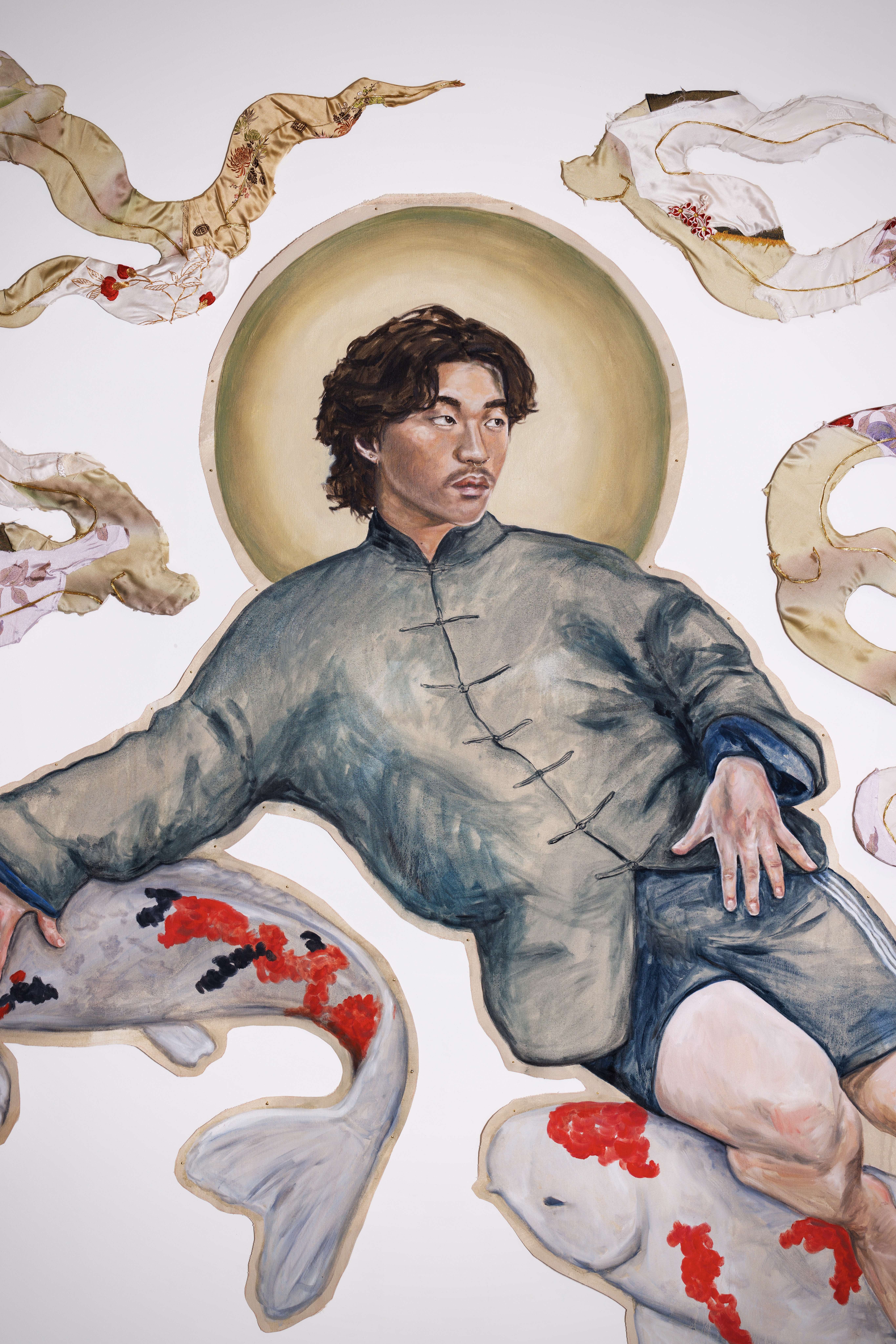
Askance - Catalogue Essay
This is an audio recording of the catalogue essay written by Jinghua Qian for the Nexus Arts gallery exhibition, Walk on by by Jake Yang. The essay is titled Askance.
When I talk to Jake, it’s just a few days into the new year, The Year of the Snake. It’s in that period of time when you’re not supposed to cut your hair, though this is a rule I only learned about a few years ago. I don’t usually like rules but I like rituals and superstitions, especially those I don’t really believe in; there is an odd satisfaction to observing something for the sake of nothing. It’s an indulgence and I believe in that, revere it even: indulgence, pleasure, beauty, these feel like simple and infinite forms of shared prosperity. That’s what I hope the new year brings, the opportunity to waste time on beauty, whether that’s creating it or just drinking it in. On a sidenote, it’s a cliché that queers love astrology and there are lots of interesting theories as to why that is. Christopher J Lee writes in Recaps magazine that astrology has a trashy appeal precisely because it rests on dubious foundations, because it is “fragile but precious”, both “intricate and unconvincing”. And isn’t that the reputation of femininity too, under patriarchy? Intricate and unconvincing. Frivolous and sentimental. Overcooked and inadequate. Sweet’n’sour.
I see this in Jake’s iconographic portraits, a celebration of femininity, beauty and resilience, an expression of cultural confidence as a queer Chinese Australian, but also evidence of the turmoil of carrying that double consciousness, as African-American thinker W.E.B. DuBois termed it, that means you’re always aware of how you’re perceived in white society. As Jake writes, the Asian figure is “undesirable, foreign, peripheral and un-Australian”. To defend oneself against these narratives feels fraught, fragile and precious; there is a hair’s breadth sometimes between countering stereotypes and inviting them to settle in your psyche, and what can you say about any of this that wouldn’t be read as frivolous, narcissistic, and shallow, too invested in appearances, kinda cringe? These are some of the ready racial stereotypes of the east in western culture, that it is decorative and decadent. Though perhaps I am projecting my own anxieties about visibility and gender too. I’m reminded of the famous John Berger quote: “You painted a naked woman because you enjoyed looking at her, put a mirror in her hand and you called the painting Vanity, thus morally condemning the woman whose nakedness you had depicted for your own pleasure.” Double consciousness, double happiness, dubious pleasure. Take what you can get and share it.
In the Chinese zodiac, Jake is a Rabbit, and so am I, albeit 12 years older. Sidenote, I’m convinced that the Chinese zodiac is mainly a covert, euphemistic way to ask someone’s age – it lacks appeal even as a dubious determinant of personality because the spans of each sign are too large. In any case, Jake is a Rabbit, and he depicts himself as such in the arms of his family – his loving mum, sister and nanna – in Nurture, a work painted on the back of embroidered decorative placemats from his nanna’s collection that have been stitched together and hardened with clear acrylic primer. The colour palette of the found textiles flow through the exhibition – beige, green, navy blue, pops of red, and a distinctive yellowy-green tone Jake uses liberally in reclamation of yellow skin. It’s a colour that appeals to me because it reads as queer and unsettling. It feels botanical, domestic, hardy, oblique. What springs to mind is that ugly-beautiful word that described us in the Linnean racial classifications: sallow. Say it slow and soft and it sounds like a term of endearment.
Hair – lush, spooling, unruly hair – features in many of Jake’s works in this exhibition. There’s the floor piece Womf, beckoning and challenging you to use it as a doormat, catching your toes between Jake’s puddling locks, weightless as smoke. There’s Flipping my goddamn hair, painted on laser-cut wood decorated with a Chinese lucky knot so this quintessential queer sass becomes a talisman for feeling yourself. There’s Serving Celestial, his self-portrait with koi fish and drifting, curling clouds that mirror the shape of his curls in the floor piece. And then there’s Eye daggers, which gives you only his eyes and a glimpse of hair. He tells me he wanted to respond to racist remarks about Asian eyes, while also suggesting eye daggers, side eye, looking askance. The almighty squint of judgement. “Sometimes that’s just the way my eyes are,” Jake says. Resting critic face. Inscrutable and scrutinising.
Jinghua Qian, pronouns ey/eir/em is a Shanghainese writer, critic and cross-platform storyteller living in the Kulin nations. Eir work has a focus on arts, history, queerness, and China.
That is the end of this audio recording.
- Artwork Serving Celestial
- Year 2025
- Medium oil on canvas, fabric, wood
- Size dimensions variable
Image credit: Rosina Possingham
-

Captured at GOODWOOD INSTITUTE on 17 Feb, 2025 by Rosina Possingham.
- Artwork Serving Celestial
- Year 2025
- Medium Oil on canvas, fabric, wood
- Size Dimensions variable, Approx. 230cmx 190cm
- Price $2,945
Image credit: Rosina Possingham
-

17 Feb, 2025 by Rosina Possingham.
- Artwork Womf (walk on my face)
- Year 2025
- Medium Fabric, thread
- Size 70cm x 107cm
- Price $885
Image credit: Rosina Possingham
-

Captured at GOODWOOD INSTITUTE on 17 Feb, 2025 by Rosina Possingham.
- Artwork Nurture
- Year 2025
- Medium oil on fabric, Chinese hanging ornaments
- Size 145cm x 130cm
- Price $1000
Image credit: Rosina Possingham
-
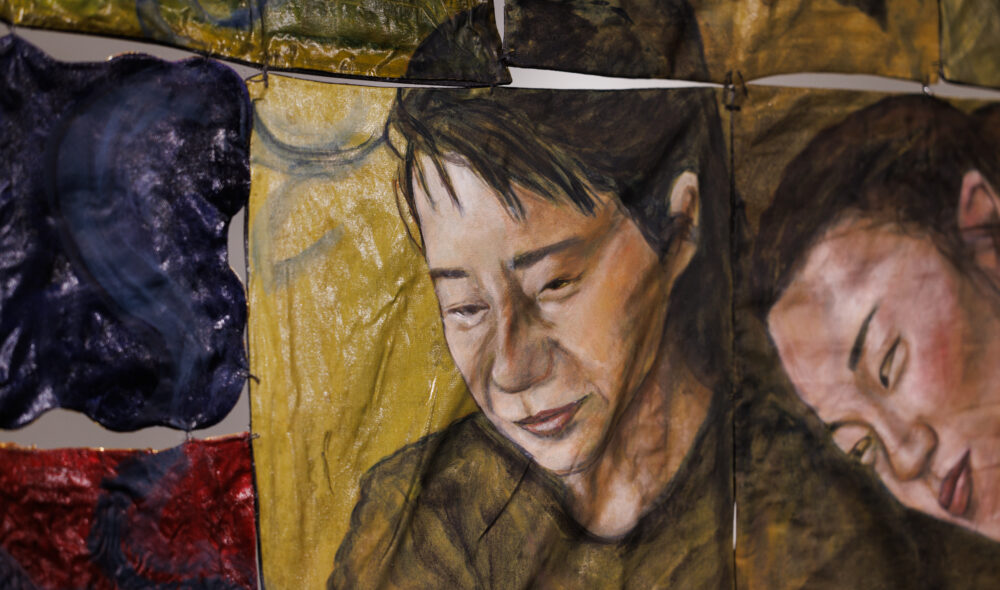
Captured at GOODWOOD INSTITUTE on 17 Feb, 2025 by Rosina Possingham.
- Artwork Nurture (detail)
- Year 2025
- Medium oil on fabric, Chinese hanging ornaments
- Size 145cm x 130cm
- Price $1000
Image credit: Rosina Possingham
-

Captured at GOODWOOD INSTITUTE on 17 Feb, 2025 by Rosina Possingham.
- Artwork Eye daggers
- Year 2025
- Medium oil on board, Chinese tassel
- Size 143cm x 43cm
- Price $650
Image credit: Rosina Possingham
-
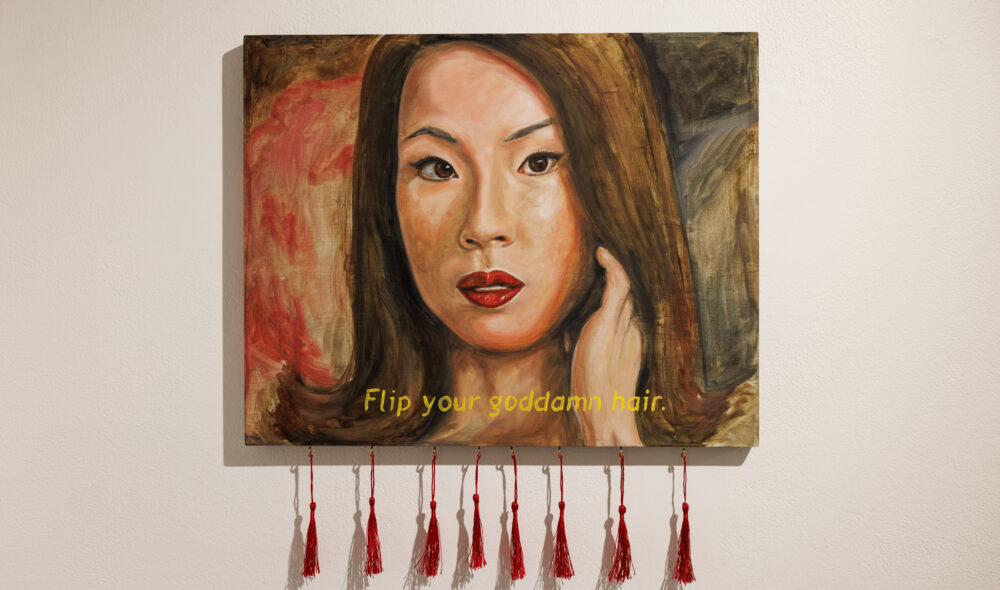
17 Feb, 2025 by Rosina Possingham.
- Artwork Flip your goddamn hair
- Year 2025
- Medium oil on board
- Size 51cm x 41cm
- Price $650
Image credit: Rosina Possingham
-
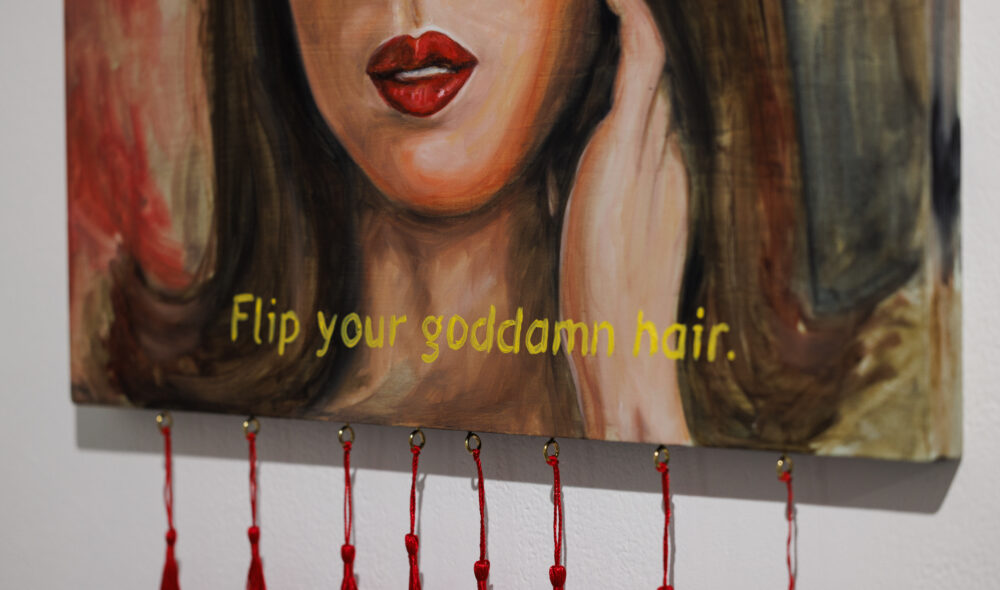
17 Feb, 2025 by Rosina Possingham.
- Artwork Flip your goddamn hair (detail)
- Year 2025
- Medium oil on board
- Size 51cm x 41cm
- Price $650
Image credit: Rosina Possingham
-
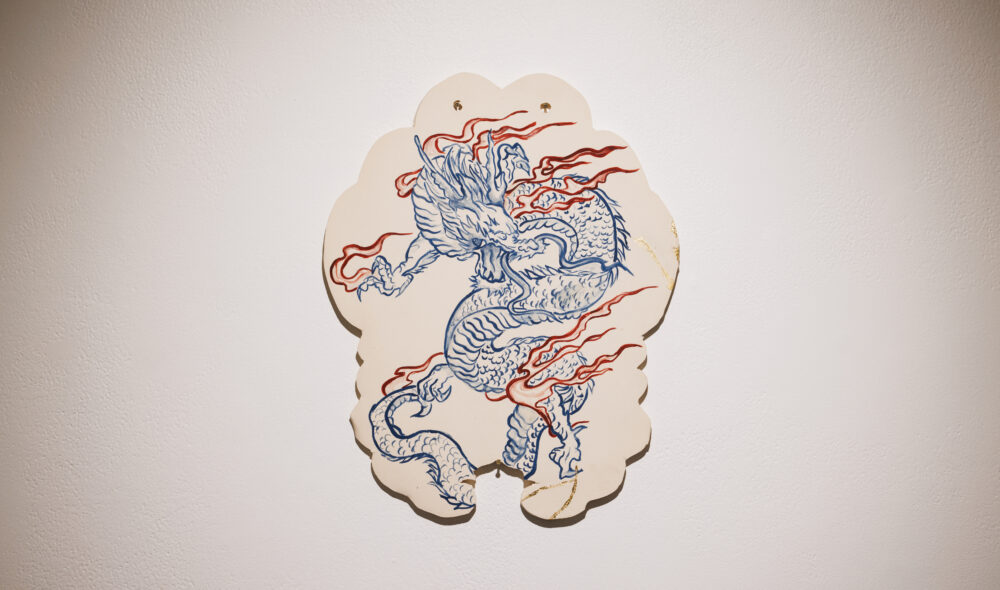
17 Feb, 2025 by Rosina Possingham.
- Artwork Lóng
- Year 2025
- Medium oil on ceramic
- Size 27cm x 35cm
- Price $530
Image credit: Rosina Possingham
-

17 Feb, 2025 by Rosina Possingham.
- Artwork Flipping my goddamn hair
- Year 2025
- Medium oil on board, Chinese lucky knot
- Size 60cm x 73cm
- Price $765
Image credit: Rosina Possingham
-
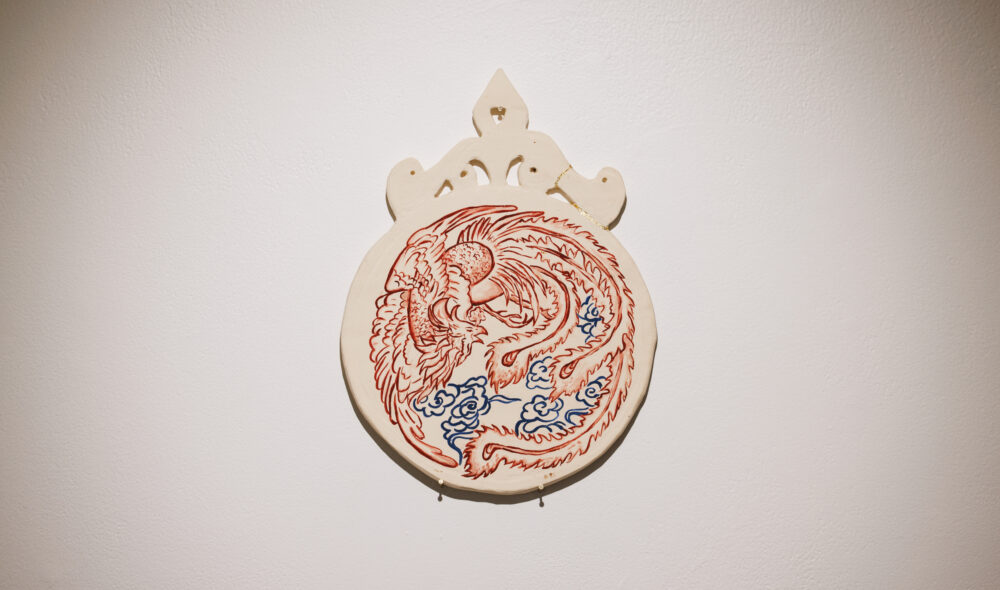
Captured at GOODWOOD INSTITUTE on 17 Feb, 2025 by Rosina Possingham.
- Artwork Féng
- Year 2025
- Medium oil on ceramic
- Size 34cm x 25cm
- Price $530
Image credit: Rosina Possingham
-

7 Feb, 2025 by Rosina Possingham.
- Artwork 'Walk on by' exhibition view
- Year 2025
Image credit: Rosina Possingham
-
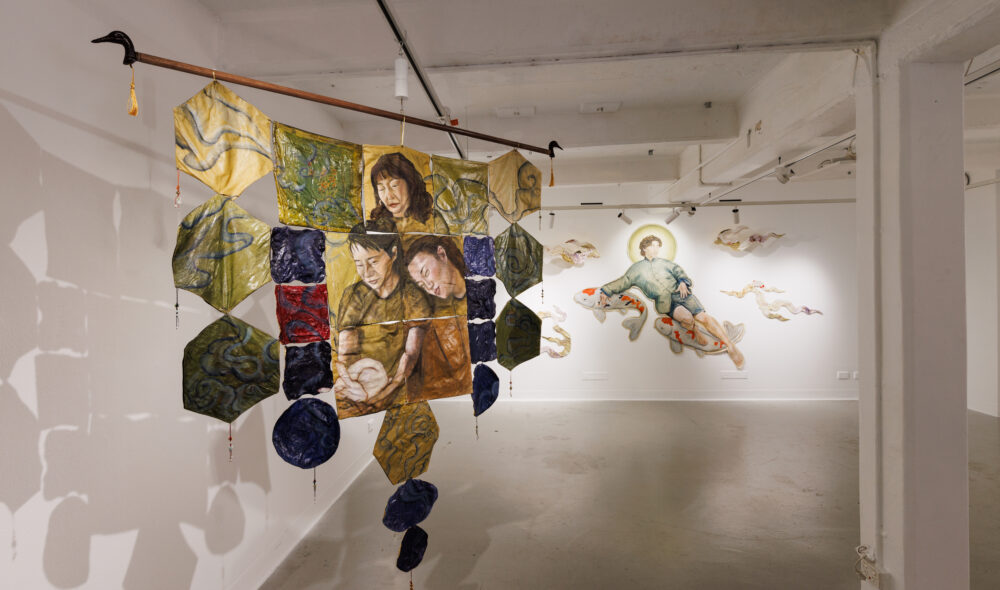
Captured at GOODWOOD INSTITUTE on 17 Feb, 2025 by Rosina Possingham.
- Artwork 'Walk on by' exhibition view
- Year 2025
Image credit: Rosina Possingham
-
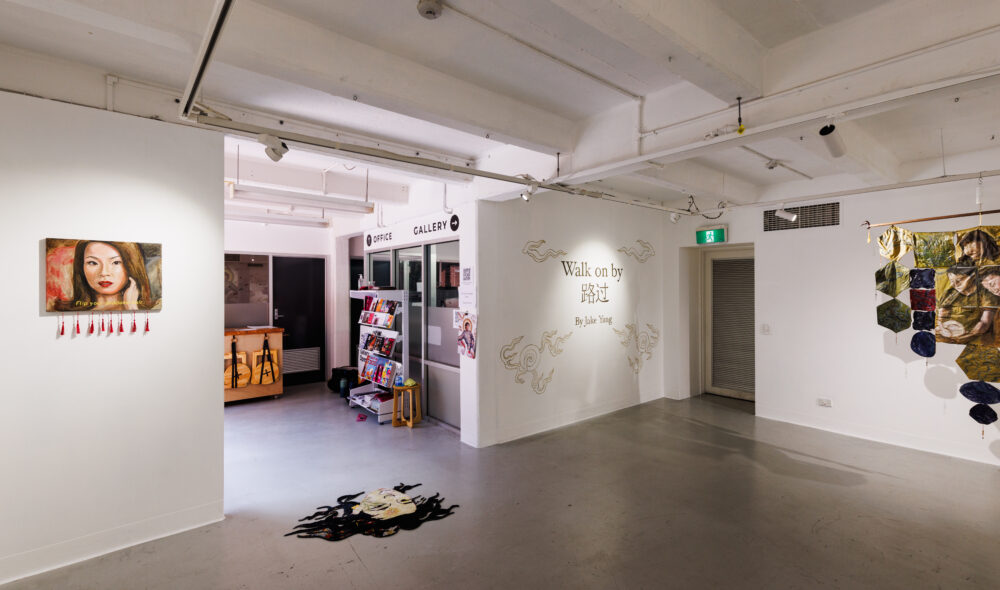
Captured at GOODWOOD INSTITUTE on 17 Feb, 2025 by Rosina Possingham.
- Artwork 'Walk on by' exhibition view
- Year 2025
Image credit: Rosina Possingham
-
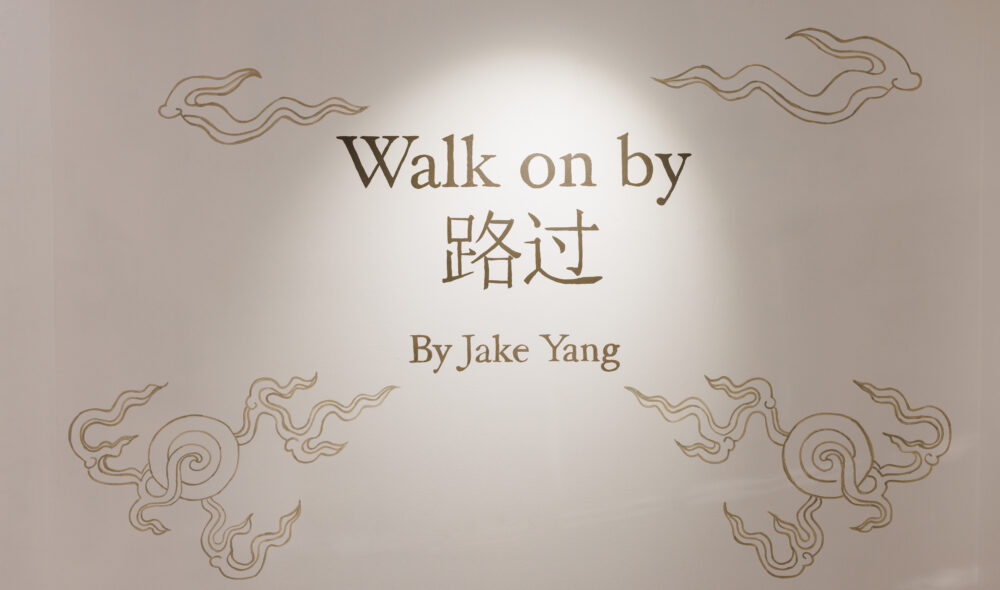
17 Feb, 2025 by Rosina Possingham.
- Artwork 'Walk on by' exhibition view
- Year 2025
Image credit: Rosina Possingham
Catalogue essay
Askance
When I talk to Jake, it’s just a few days into the new year, The Year of the Snake. It’s in that period of time when you’re not supposed to cut your hair, though this is a rule I only learned about a few years ago. I don’t usually like rules but I like rituals and superstitions, especially those I don’t really believe in; there is an odd satisfaction to observing something for the sake of nothing. It’s an indulgence and I believe in that, revere it even: indulgence, pleasure, beauty, these feel like simple and infinite forms of shared prosperity. That’s what I hope the new year brings, the opportunity to waste time on beauty, whether that’s creating it or just drinking it in. On a sidenote, it’s a cliché that queers love astrology and there are lots of interesting theories as to why that is. Christopher J Lee writes in Recaps magazine that astrology has a trashy appeal precisely because it rests on dubious foundations, because it is “fragile but precious”, both “intricate and unconvincing”. And isn’t that the reputation of femininity too, under patriarchy? Intricate and unconvincing. Frivolous and sentimental. Overcooked and inadequate. Sweet’n’sour.
I see this in Jake’s iconographic portraits, a celebration of femininity, beauty and resilience, an expression of cultural confidence as a queer Chinese Australian, but also evidence of the turmoil of carrying that double consciousness, as African-American thinker W.E.B. DuBois termed it, that means you’re always aware of how you’re perceived in white society. As Jake writes, the Asian figure is “undesirable, foreign, peripheral and un-Australian”. To defend oneself against these narratives feels fraught, fragile and precious; there is a hair’s breadth sometimes between countering stereotypes and inviting them to settle in your psyche, and what can you say about any of this that wouldn’t be read as frivolous, narcissistic, and shallow, too invested in appearances, kinda cringe? These are some of the ready racial stereotypes of the east in western culture, that it is decorative and decadent. Though perhaps I am projecting my own anxieties about visibility and gender too. I’m reminded of the famous John Berger quote: “You painted a naked woman because you enjoyed looking at her, put a mirror in her hand and you called the painting Vanity, thus morally condemning the woman whose nakedness you had depicted for your own pleasure.” Double consciousness, double happiness, dubious pleasure. Take what you can get and share it.
In the Chinese zodiac, Jake is a Rabbit, and so am I, albeit 12 years older. Sidenote, I’m convinced that the Chinese zodiac is mainly a covert, euphemistic way to ask someone’s age – it lacks appeal even as a dubious determinant of personality because the spans of each sign are too large. In any case, Jake is a Rabbit, and he depicts himself as such in the arms of his family – his loving mum, sister and nanna – in Nurture, a work painted on the back of embroidered decorative placemats from his nanna’s collection that have been stitched together and hardened with clear acrylic primer. The colour palette of the found textiles flow through the exhibition – beige, green, navy blue, pops of red, and a distinctive yellowy-green tone Jake uses liberally in reclamation of yellow skin. It’s a colour that appeals to me because it reads as queer and unsettling. It feels botanical, domestic, hardy, oblique. What springs to mind is that ugly-beautiful word that described us in the Linnean racial classifications: sallow. Say it slow and soft and it sounds like a term of endearment.
Hair – lush, spooling, unruly hair – features in many of Jake’s works in this exhibition. There’s the floor piece Womf, beckoning and challenging you to use it as a doormat, catching your toes between Jake’s puddling locks, weightless as smoke. There’s Flipping my goddamn hair, painted on laser-cut wood decorated with a Chinese lucky knot so this quintessential queer sass becomes a talisman for feeling yourself. There’s Serving Celestial, his self-portrait with koi fish and drifting, curling clouds that mirror the shape of his curls in the floor piece. And then there’s Eye daggers, which gives you only his eyes and a glimpse of hair. He tells me he wanted to respond to racist remarks about Asian eyes, while also suggesting eye daggers, side eye, looking askance. The almighty squint of judgement. “Sometimes that’s just the way my eyes are,” Jake says. Resting critic face. Inscrutable and scrutinising.
Jinghua Qian
February 2025
Writer
Audio transcript of Jake Yang’s biography.
Meet the artists & curators
Jake Yang is a recent graduate of Adelaide Central School of Art, Kaurna Land, Adelaide. He explores various disciplines, notably painting, sculpture, textiles, and installation.
Yang’s art practice explores queer youth culture and the way it sits alongside and intersects with his cultural background, raised in a conservative traditional Chinese culture.
In Yang’s work privacy, intimacy, care, and freedom are celebrated in lush, safe natural environments. He challenges the normative assumptions through an examination of intersecting identities and existing in three very different cultures simultaneously (Chinese, Australian and queer).
His practice explores internal conflict, a sense of fracture as well as the longing for cross- sacredness and celebration of safe spaces.
Yang’s painting practice is influenced by traditional Chinese cultural artefacts and techniques as a means of connecting back to his neglected cultural identity growing up. Exploring queer culture and personal relationships in art is a practice of empowerment, self-development and self-acceptance.



